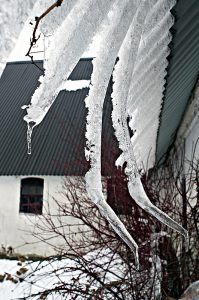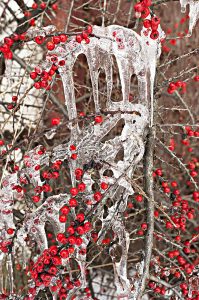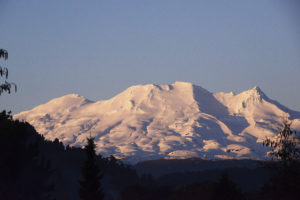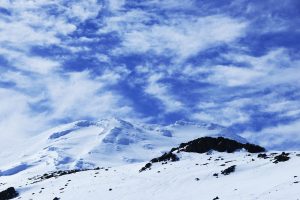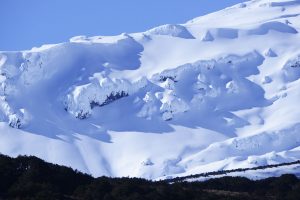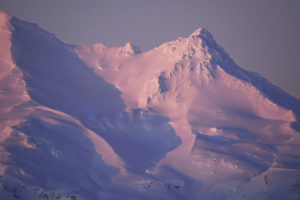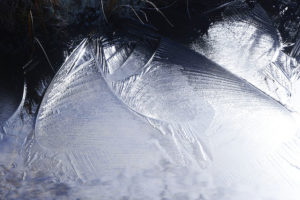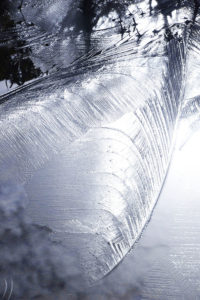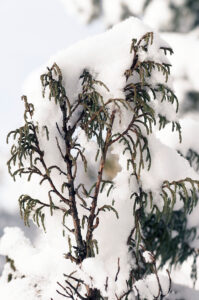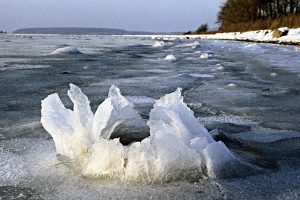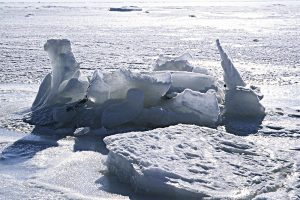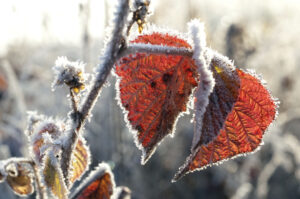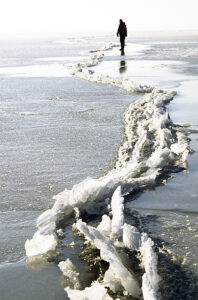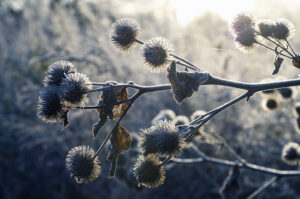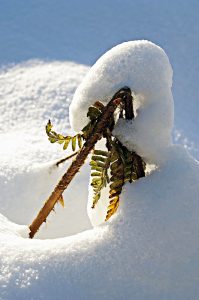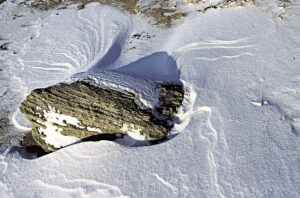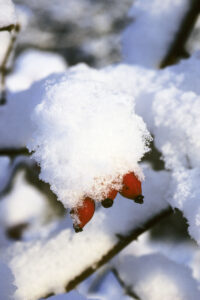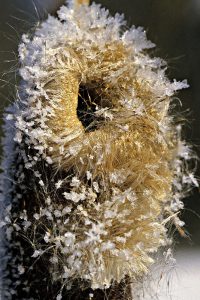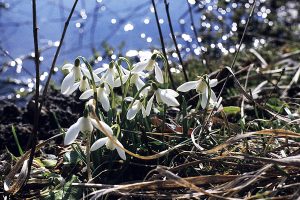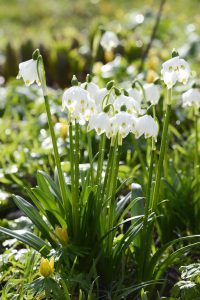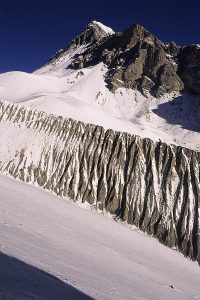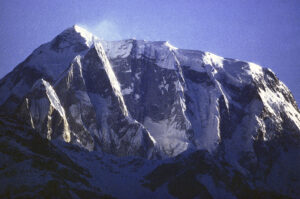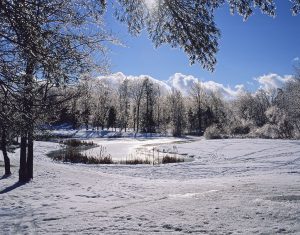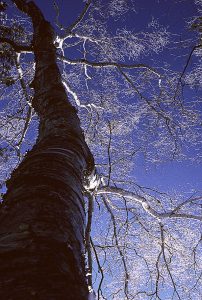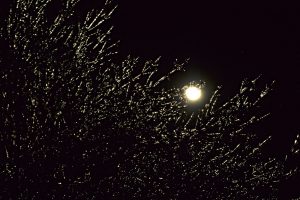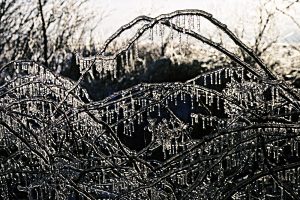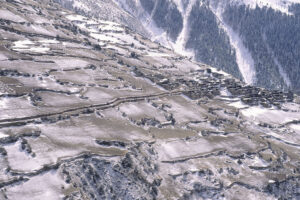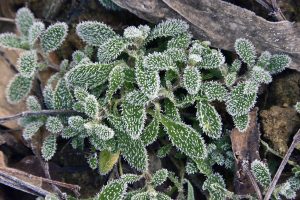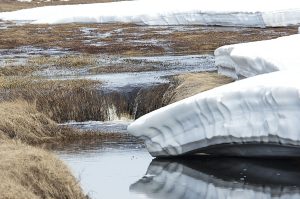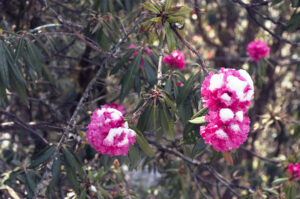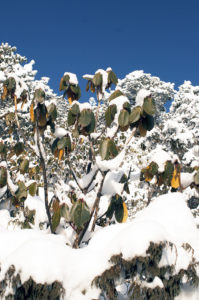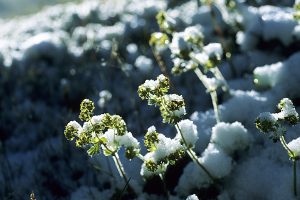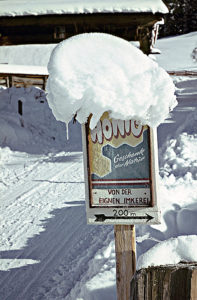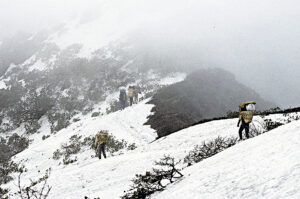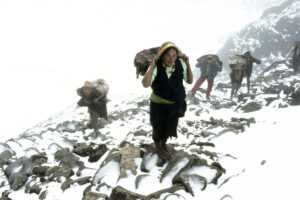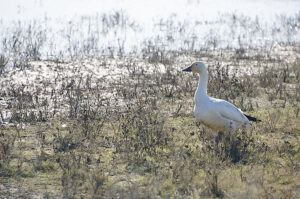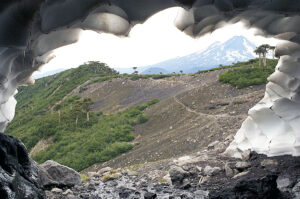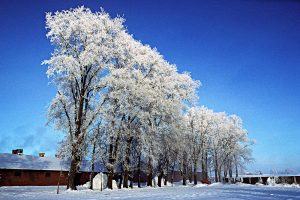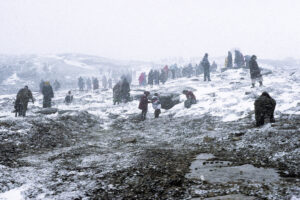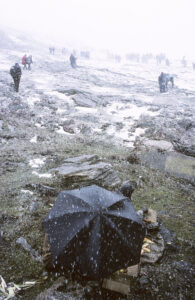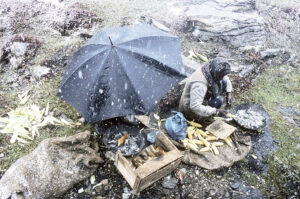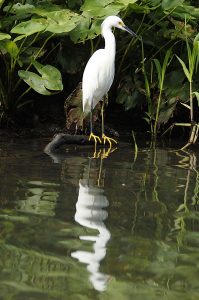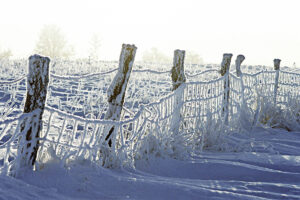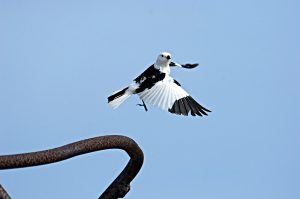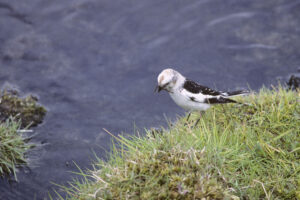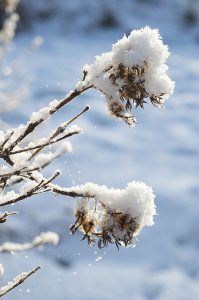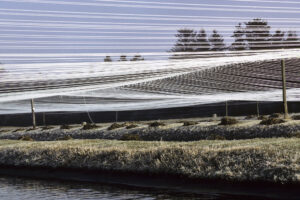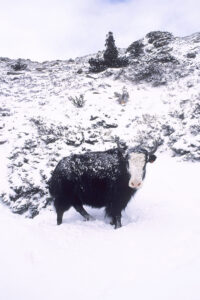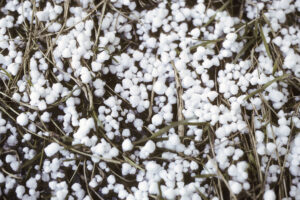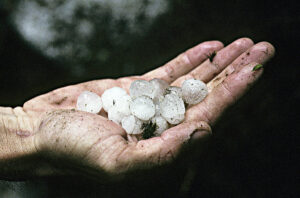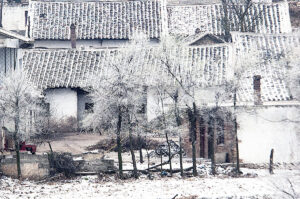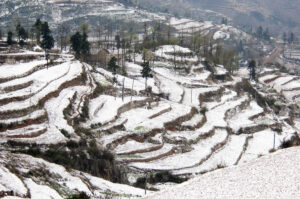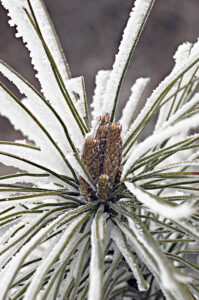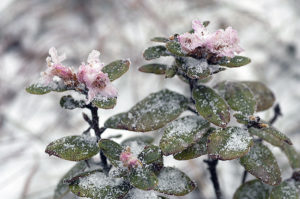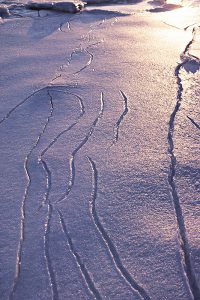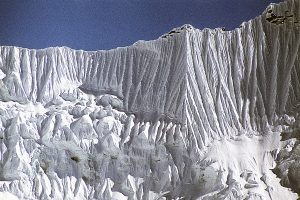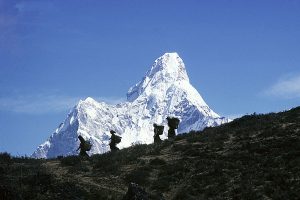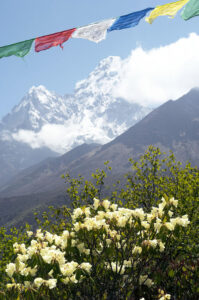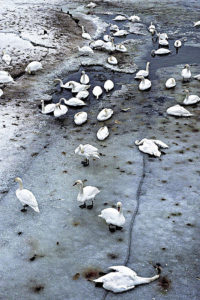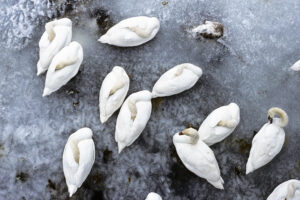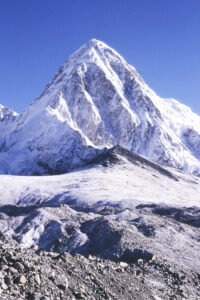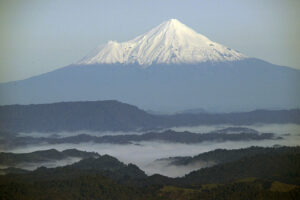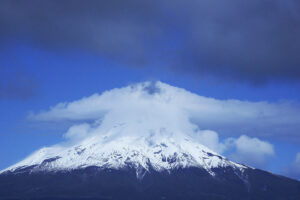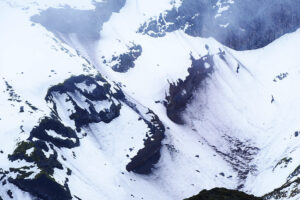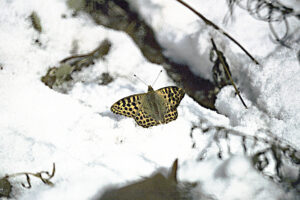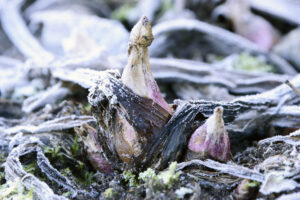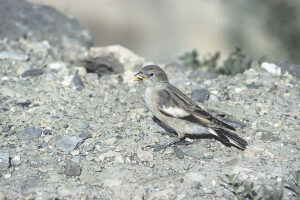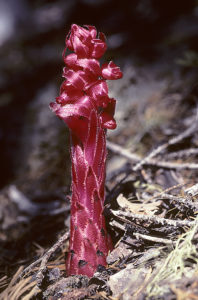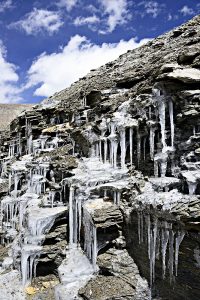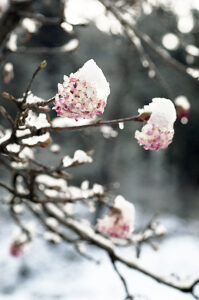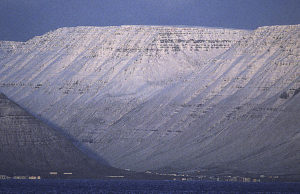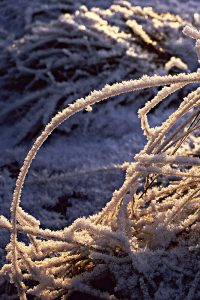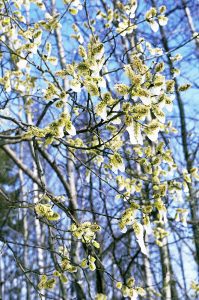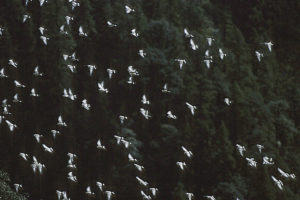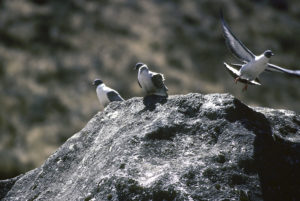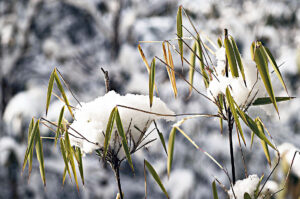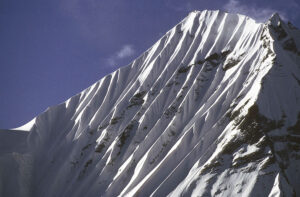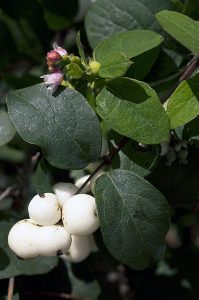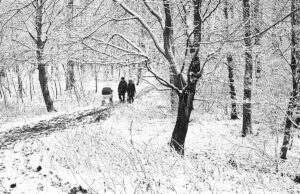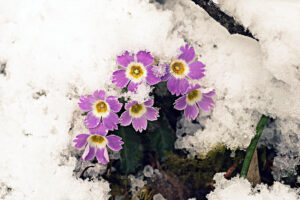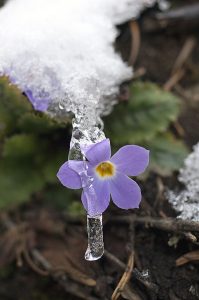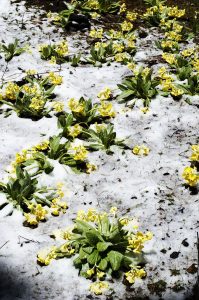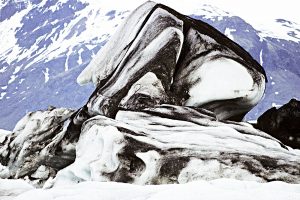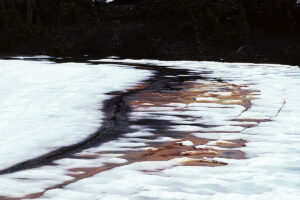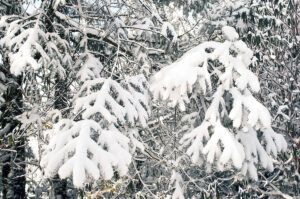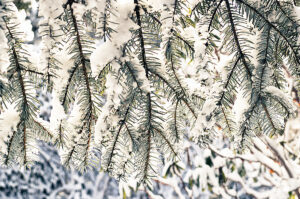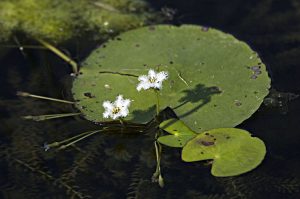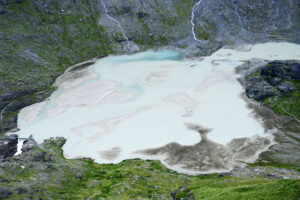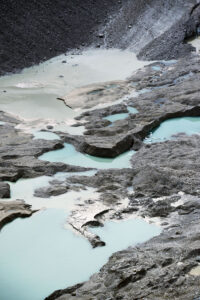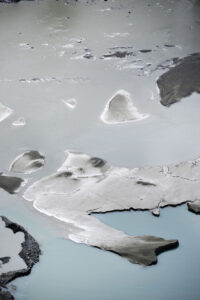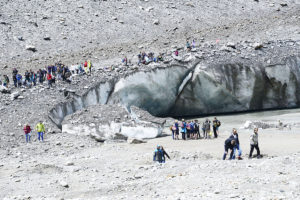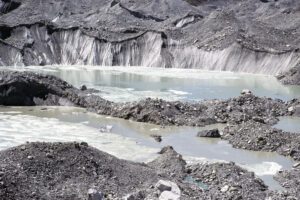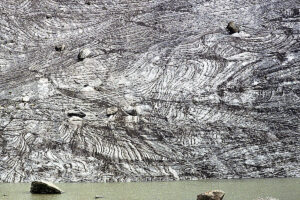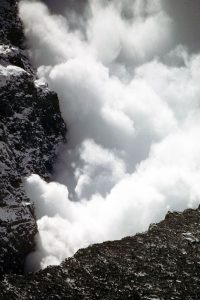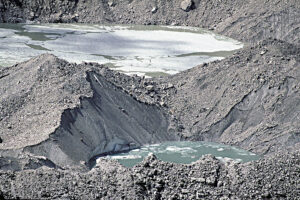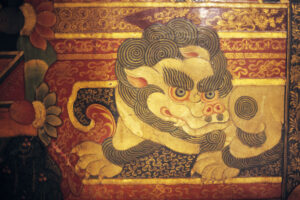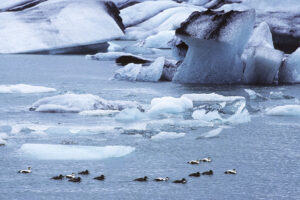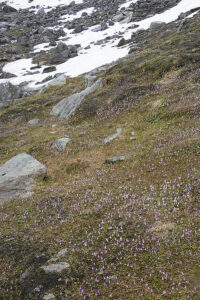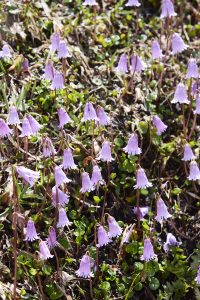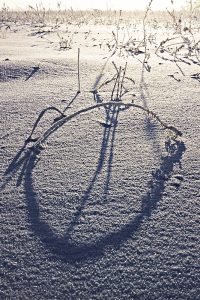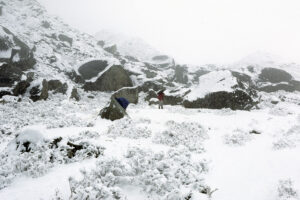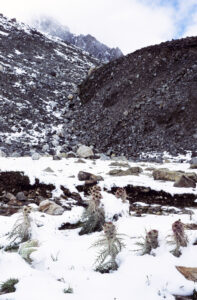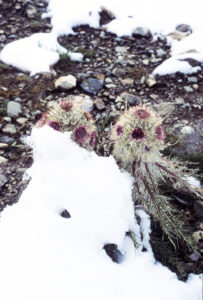Snow and ice
These icicles, hanging down from a barn roof in Funen, Denmark, have been bent inwards by repeated thawing and freezing. (Photo copyright © by Kaj Halberg)
Melted snow from the icicles in the picture above has frozen on a cotoneaster below. (Photo copyright © by Kaj Halberg)
Some say the world will end in fire,
Some say in ice.
From what I’ve tasted of desire
I hold with those who favor fire.
But if it had to perish twice,
I think I know enough of hate
To say that for destruction ice
Is also great
And would suffice.
By American poet Robert Frost (1874-1963), first published in Harper’s Magazine 1920.
Drying socks, covered in rime, Jutland, Denmark. (Photo copyright © by Kaj Halberg)
Tongariro National Park is situated in the southern part of the North Island of New Zealand, centered around three active volcanoes, Ruapehu (2797 m), Ngauruhoe (2291 m), and Tongariro (1978 m). This park, which covers 786 km2, was established as early as 1887, thus being among the oldest national parks in the world. For the major part of the year, the higher areas of the park are covered in snow.
In fact, Ruapehu is a name that includes a number of peaks, of which the tallest is Tahurangi (2797 m), whereas a striking pointed peak is Girdlestone (2658 m). Initially, this mountain was named Little Matterhorn Peak by Hubert Earle Girdlestone (1879-1918), a New Zealand explorer and war hero, who was killed in France in 1918. His friends installed a plaque on the mountain in 1922, renaming it Girdlestone Peak.
Various views of a snow-covered Ruapehu, at various times of the day, seen from the south. The pointed mountain is Girdlestone Peak. (Photos copyright © by Kaj Halberg)
Following a night with slight frost, very thin sheets of ice are covering a pond in Tongariro National Park. (Photos copyright © by Kaj Halberg)
Junipers (Juniperus) are conifers of the cypress family (Cupressaceae), comprising between 50 and 67 species, depending on authority. These trees and shrubs are widely distributed throughout the Northern Hemisphere. This genus is described on the pages Plants: Plants in folklore and poetry, and Plants: Ancient and huge trees.
Drooping juniper (Juniperus recurva) is native to the Himalaya, from northern Pakistan eastwards to the Yunnan Province, south-western China, growing at altitudes between 1,800 and 4,600 m. The specific name is from the Latin recurvo (’bent backwards’), like the common name referring to the drooping branches.
Foliage and wood of this species are burned as incense at Buddhist and Hindu shrines, and near the Pangboche Buddhist Monastery in Khumbu, eastern Nepal, is a sacred growth of this tree, depicted on the page Religion: Animism.
These branches of drooping juniper are covered in newly fallen snow, between Tharepati and Melamchigaon, Langtang National Park, central Nepal.
In the 1980s and 1990s, I spent several winters on the island of Vorsø, a nature reserve in Horsens Fjord, Denmark. During these stays, I could enjoy a number of very beautiful impressions. Below, a collection of winter pictures from this interesting reserve is presented. Others are shown on the page Nature Reserve Vorsø.
In severe winters, each falling tide leaves a thin layer of frozen saltwater on emerging stones. The following rising tide will press this layer outwards, leaving a new thin layer of ice inside the previous layer. In this way, several rising and falling tides create a ’flower’ with delicate ice petals. (Photo copyright © by Kaj Halberg)
Other ice sculptures, created around stones in Horsens Fjord. (Photos copyright © by Kaj Halberg)
Leaves of dewberry (Rubus caesius), covered in rime. (Photo copyright © by Kaj Halberg)
The sun sets in an orgy of red and orange over Horsens Fjord, adorning the sea ice with gorgeous patterns. (Photo copyright © by Kaj Halberg)
These catkins of common hazel (Corylus avellana) were formed already in late autumn, and now they are covered in rime, ready to burst with the first sign of spring. (Photo copyright © by Kaj Halberg)
Ice flakes, pushed up along a crack in the sea ice. (Photo copyright © by Kaj Halberg)
Fruits of great burdock (Arctium lappa), covered in rime. – This species is described in depth on the page Plants: Plants in folklore and poetry. (Photo copyright © by Kaj Halberg)
Today, the common male fern (Dryopteris filix-mas) has taken over huge areas of the former fields on Vorsø. This partly withered plant is almost covered by snow. (Photo copyright © by Kaj Halberg)
Wind-made patterns in a compact layer of snow around a coastal stone on the southern shore of the island. (Photo copyright © by Kaj Halberg)
Hips of dog rose (Rosa canina), covered in snow. This plant is extremely common on Vorsø. (Photo copyright © by Kaj Halberg)
Fruit spike of common bulrush (Typha latifolia), covered in rime. (Photo copyright © by Kaj Halberg)
In Taiwan, ice-covered roads are a rare phenomenon, only occurring in the highest mountains in the central part of the island. As ice on the roads is so rare, it is not customary to strew salt, and drivers have difficulty passing the oce-covered parts.
In January 2020, my friend Niels Andreasen and I passed an ice-covered part of the road leading up to the high mountain Hohuan Shan. Several cars were stranded here, as the drivers had no experience with such roads, and they speed up far to much to pass.
Cars, stranded on the road across Hohuan Shan, central Taiwan. (Photo copyright © by Kaj Halberg)
Snowdrop (Galanthus) is a genus of c. 20 species in the amaryllis family (Amaryllidaceae), most of which are native to the Balkans, the Near East, the Caucasus, and the Alborz Mountains of northern Iran. One species, the common snowdrop (G. nivalis), is found from northern Spain and western France eastwards to Ukraine, but has become naturalized elsewhere in Europe and in parts of North America.
The generic name is from the Greek gala (‘milk’) and anthos (‘flower’), referring to the white flowers of the genus, whereas the specific name nivalis (‘of the snow’) refers to the early flowering of common snowdrop. The name snowdrop first appeared in 1633, in the book Great Herball by English herbalist John Gerard (c. 1545-1612). (In the first edition of his book, Gerard had named it the timely flowring bulbus violet.) The word snowdrop may be a translation of the German word Schneetropfen – a type of earring, which was popular in those days. Other common English names include February fairmaids, dingle-dangle, Candlemas bells, Mary’s tapers, and, in Yorkshire, snow piercers. (Sources: M. Bishop, A. Davis & J. Grimshaw 2002. Snowdrops: A Monograph of Cultivated Galanthus. Griffin Press, and R. Mabey 1996. Flora Britannica. Sinclair-Stevenson)
An old legend relates that when Adam and Eve were expelled from the Garden of Eden, they experienced dark and cold for the first time, and Eve sat down on the cold ground and wept. An angel appeared before her, caught a snow flake in his hand and blew on it. The water drop fell to the ground, and a snowdrop appeared. This gave comfort to Eve, who began to have new hope.
Common snowdrop is one of the first harbingers of spring, often appearing before the winter snow has disappeared. It is cultivated everywhere in northern Europe and often escapes, in this case in Nature Reserve Vorsø, Horsens Fjord, Denmark. (Photo copyright © by Kaj Halberg)
Spring snowflake (Leucojum vernum) resembles common snowdrop, but has wider, bell-shaped flowers with a yellowish-green spot on each petal. Formerly, the genus Leucojum contained 11 species, but in 2004 nine of these were moved to the genus Acis. Today, only L. vernum and L. aestivum remain in Leucojum. The generic name is derived from the Greek leukos (‘white’) and ion (‘violet’).
Spring snowflake is also widely cultivated, here on the island of Funen, Denmark. (Photo copyright © by Kaj Halberg)
If you walk around the Annapurna Range, central Nepal, you must cross over the pass Thorung La (5415 m). People in this area are mainly Buddhists, and the peak of this pass is marked by a chorten (a Tibetan variety of the stupa) and vividly coloured prayer flags.
Chortens, prayer flags, and other Buddhist subjects are described in depth on the page Religion: Buddhism.
Morning sun, illuminating snow-covered mountains around the Thorung La Pass. (Photo copyright © by Kaj Halberg)
Eroded gullies near Thorung La. (Photo copyright © by Kaj Halberg)
The snow leopard (Panthera uncia) lives in mountains of Central Asia, but has been hunted to extinction in many areas because of its rich and beautiful fur. In Buddhist areas of the Himalaya, hunting is banned, and in these areas this rare cat has safe havens, where it can prey on species like bharal (Pseudois nayaur), urial (Ovis vignei), Himalayan tahr (Hemitragus jemlahicus), and Himalayan musk deer (Moschus chrysogaster).
One morning, in the Jarsang Khola Valley, we found these partly melted pugmarks in the snow, signifying that a snow leopard had passed here the previous night. (Photo copyright © by Kaj Halberg)
The black Eurasian coot (Fulica atra) is a member of the large family Rallidae, comprising coots, gallinules, rails, crakes, and many others. As a breeding bird, it is widely distributed across Temperate Eurasia, eastwards to Japan, and in north-western Africa, the Indian Subcontinent, New Guinea, and Australia. Siberian populations are migratory, whereas African, Indian, Australian, and most European birds are resident. Very similar species are found in the Iberian Peninsula, Africa, the Americas, and Hawaii.
Coots, walking on the ice-covered Lake Hornborgasjön, Västergötland, Sweden. (Photo copyright © by Kaj Halberg)
With a height of 7,939 m, Annapurna II is the second-tallest mountain in the Annapurna Range north of Pokhara, Nepal.
Annapurna II and surrounding peaks, shortly after dawn, seen from Pokhara. (Photo copyright © by Kaj Halberg)
Rays from the rising sun illuminate the snow-clad peak of Annapurna II, seen from the Upper Marsyangdi Valley. (Photo copyright © by Kaj Halberg)
In January 1999, I spent some days in and around Portland, Maine, United States – days of freezing temperatures and heavy wind. It was indeed a cold, but also very beautiful experience, as is obvious from the following pictures.
Frozen pond, surrounded by trees, covered in frozen rain, Cape Elizabeth. (Photo copyright © by Kaj Halberg)
Frozen rain on a paper birch (Betula papyrifera), Freeport. (Photo copyright © by Kaj Halberg)
Branches, covered in frozen rain, shining like silver under a Full Moon, Portland. (Photos copyright © by Kaj Halberg)
This snowman in Portland partly melted in the sunshine, causing it to tilt. However, during the night it froze again, assuming an unusual position. (Photo copyright © by Kaj Halberg)
Slight snowfall has left a thin snow cover on these walled fields near the village of Ghyaru, Upper Marsyangdi Valley, Annapurna, central Nepal. (Photo copyright © by Kaj Halberg)
Common mouse-ear chickweed (Cerastium fontanum), of the campion family (Caryophyllaceae), is common in grassy areas and in fields in the major part of Europe, and has also been introduced elsewhere.
Rime-covered leaves of common mouse-ear chickweed, central Jutland, Denmark. (Photo copyright © by Kaj Halberg)
In 2011, I participated in an expedition to the Chukotka Peninsula, north-eastern Siberia. Our adventures on this trip are related on the page Travel episodes – Siberia 2011: Caterpillar trip in Chukotka.
Our transportation in Chukotka took place in an old army caterpillar. In this picture, it is crossing a stream, bordered by snow walls. (Photo copyright © by Kaj Halberg)
Spring in Chukotka: Meltwater and snow walls along a stream. (Photo copyright © by Kaj Halberg)
Rhododendron arboreum is the largest among c. 100 species of rhododendron in the Himalaya, growing to 15 m tall. It is very common, and in March-April, when it is flowering, parts of the forest show a reddish or pinkish tinge, stemming from millions of flowers. The intensity of the red colour of the flowers decreases, as you move higher, and near the upper limit of its distribution, you sometimes encounter trees with white flowers. This tree is the national plant of Nepal, called lali guras (‘red rhododendron’).
Inflorescences of Rhododendron arboreum, partly covered in snow, Dodi Tal, Uttarakhand, northern India. (Photo copyright © by Kaj Halberg)
The specific name of the bell rhododendron (Rhododendron campanulatum), from the Latin campanula (‘little bell’), refers to its bell-shaped flowers. This attractive shrub is very common in the Himalaya, forming dense thickets at altitudes between 2,800 and 4,000 m. One of the characteristics of this species is the rusty-coloured layer of hairs on the underside of the leaves.
Bell rhododendron, covered in newly fallen snow, between Tharepati and Melamchigaon, Langtang National Park, central Nepal. (Photo copyright © by Kaj Halberg)
In the summer 1999, I joined a group of Scandinavians on a hike in the Tien Shan Mountains of Kyrgyzstan.
Mountains, snow, and fog, Kaska Su Valley. (Photo copyright © by Kaj Halberg)
Horse riders in a snow-covered landscape, Arashan Valley. – The domestication of the horse is described on the page Animals: Animals as servants of Man. (Photo copyright © by Kaj Halberg)
This lady’s mantle (Alchemilla) has been covered in snow during the night, Kaska Su Valley. – The medicinal usage of lady’s mantle is described on the page Plants: Plants in folklore and poetry. (Photo copyright © by Kaj Halberg)
This sign in the Lammartal Valley, Austria, says ‘Honey for sale’. Presumably, it was placed here in the summertime, but maybe there is still a few jars left? (Photo copyright © by Kaj Halberg)
The Barun Valley is an alpine valley, situated in Makalu-Barun National Park, which covers an area of c. 1,500 km2 in northern Nepal. To the west, this park borders Sagarmatha National Park, covering 1148 km2, to the north the huge Qomolangma Nature Preserve in Tibet, covering c. 35,000 km2, and to the south a buffer zone, covering 830 km2. Thus, the valley is situated in the heart of a very large protected area.
In spring 1991, together with Lars Nørgaard Hansen, I undertook a very interesting hike to this valley, related on the page Plants – Plant hunting in the Himalaya: The rhododendron valley.
Our porters, struggling through snow and fog near the Shipton La Pass (4,216 m). (Photo copyright © by Kaj Halberg)
On our way across this pass, we met another group of porters, heading the opposite way. Note that the woman is bare-footed. If she had been one of our porters, we would have bought her a pair of sneakers! Unfortunately, we did not have a spare pair to give her. (Photo copyright © by Kaj Halberg)
The snow goose (Anser caerulescens) comes in two colour morphs, a snow-white phase, which has given this species its common name, and a bluish-grey phase, referred to as ‘blue goose’, which has given it the specific name caerulescens, meaning ‘bluish’.
The snow goose is a bird of the New World, breeding mainly in northern Canada and Alaska, with small populations in Greenland and north-eastern Siberia. It spends the winter along the Pacific coast, from southern British Columbia southwards, and also in southern United States and Mexico.
Snow goose, Sacramento National Wildlife Refuge, California. (Photo copyright © by Kaj Halberg)
In 2011, Lars Skipper and I spent a month in Chile. One of the highlights of this trip was a visit to Parque Nacional Conguillio. Our adventures in this park are related in detail on the page Travel episodes – Chile 2011: The white forest.
View from inside an ice cave in the Sierra Nevada, Parque Nacional Conguillio. The taller trees with white trunks are the national tree of Chile, pehuén (Araucaria araucana), described on the page mentioned above. (Photo copyright © by Kaj Halberg)
Poplars (Populus), also called aspen or cottonwood, of the willow family (Salicaceae), are a genus of anywhere between 25 and 35 species of trees, some of which are indeed majestic, growing to 50 m tall, and with a trunk diameter up to 2.5 m. Poplars are deciduous, and several species display brilliant yellow foliage in the autumn. Some examples are shown on the page In praise of the colour yellow.
Poplars are native to the major part of the Northern Hemisphere, from subarctic areas southwards to Mexico, North Africa, Iran, the Himalaya, and China.
Snow, falling on poplar trees, Massachusetts, United States. (Photo copyright © by Kaj Halberg)
The Canadian poplar (Populus x canadensis) is a hybrid between black poplar (Populus nigra), which is native to Europe, south-western and central Asia, and North Africa, and eastern cottonwood, or necklace poplar (Populus deltoides), which is native to the United States, south-eastern Canada, and north-eastern Mexico. This hybrid is very commonly planted around the world, often along roads.
Canadian poplars, covered in rime, Jutland, Denmark. (Photo copyright © by Kaj Halberg)
In spring and autumn, the Rohtang La Pass (3978 m), Himachal Pradesh, northern India, is a very popular destination for Indian tourists, and below the pass, numerous dhabas (small road-side restaurants) have sprung up helter-skelter. Also, woollen hats and other warm clothes are sold to the lowlanders who are very sensitive to cold.
Despite a raging snowstorm, these lowland Indians explore the snow at Rohtang La, dressed in huge overcoats to be able to stand the cold. (Photo copyright © by Kaj Halberg)
Meanwhile, two roadside vendors continue roasting corn cobs, seeking shelter under a huge umbrella. (Photos copyright © by Kaj Halberg)
The snowy egret (Egretta thula) is named after its snow-white plumage. This small heron, which is very similar to the Old World little egret (E. garzetta), is found in South and Central America, and also in parts of North America, where some populations are migratory, wintering further south.
The generic name is from a French word, aigrette, meaning ‘little heron’. In 1782, the specific name, thula, was given to this bird by a mistake by Chilean Jesuit priest and naturalist Juan Ignacio Molina (1740-1829), who didn’t realize that in fact thula was the local Mapuduncun name for the black-necked swan (Cygnus melancoryphus).
Snowy egret, Tortuguero National Park, Limón, Costa Rica. (Photo copyright © by Kaj Halberg)
Tombstones, partly covered by snow, in a Jewish cemetery in Copenhagen, Denmark. – Many other pictures, depicting tombstones, are presented on the page Culture: Graves. (Photo copyright © by Kaj Halberg)
Rime-covered fence, Jutland, Denmark. (Photo copyright © by Kaj Halberg)
The snow bunting (Plectrophenax nivalis) is aptly named, as it breeds in the High Arctic, spending the winter in snowy fields and coastal meadows further south. Its plumage is also predominantly snow-white. This species has a northern circumpolar distribution, with isolated populations in northern Scotland, the Faroe Islands, Iceland, and Cape Breton, Nova Scotia. A close relative, McKay’s bunting (P. hyperboreus), has even more white in the plumage. It is restricted to two small islands in the Bering Sea.
The generic name is from the Greek plektron (‘cock’s spur’) and phenax (‘imposter’, i.e. ‘replacement’). This probably alludes to the shorter claw on the hindfoot of these birds, compared to their close relatives, the longspurs (Calcarius). The specific name is from the Latin nix (‘snow’) and -alis (‘like’), of course referring to the plumage of this bird.
Previously, snow buntings were placed in the bunting family (Emberizidae), but recent DNA research has concluded that they, together with the longspurs, form a separate family, Calcariidae.
Male snow bunting, taking off from a rusty pipe, Chukotka, Siberia. (Photo copyright © by Kaj Halberg)
This male snow bunting has caught a crane fly, Aðaldal, northern Iceland. (Photo copyright © by Kaj Halberg)
Beauty bush (Linnaea amabilis, also known as Kolkwitzia amabilis), of the honeysuckle family (Caprifoliaceae), originates in China, but is widely cultivated for its beautiful flowers. It was described by German botanist Paul Graebner (1871-1933), who named the genus Kolkwitzia in honour of Richard Kolkwitz (1873-1956), professor of botany in Berlin. The specific name means ‘lovely’.
In 2013, following genetic research, it was suggested that Kolkwitzia and other genera should be included in the genus Linnaea, which, until then, contained a single species, the twin flower (Linnaea borealis) – the favourite plant of Swedish naturalist Carolus Linnaeus (1707-1778), also called Carl von Linné. As he was also quite fond of himself, he decided to name this plant Linnaea!
Withered inflorescences of beauty bush, covered in rime, Funen, Denmark. A gust of wind blows off some of the rime. (Photo copyright © by Kaj Halberg)
Rime-covered wires above ponds in a fish farm, Jutland, Denmark. The wires are hung up to keep herons and cormorants away. (Photo copyright © by Kaj Halberg)
Snowcocks (Tetraogallus) are a group of five large species of game birds, distributed in montane areas from eastern Turkey and the Caucasus eastwards to Central Asia and western China.
The Tibetan snowcock (Tetraogallus tibetanus) is widely distributed in Central Asian mountains, from Tajikistan southeast along the Himalaya to Arunachal Pradesh, and thence northwards through western China to Qinghai, and from there westwards to the Kunlun Mountains. It avoids desert areas of the Tibetan Plateau.
Tibetan snowcock is rather common in drier areas of the higher parts of the Himalaya. These birds are feeding near Tughla, Sagarmatha National Park, Khumbu, eastern Nepal. (Photo copyright © by Kaj Halberg)
Pack ice, which has been pushed ashore, eastern Jutland, Denmark. (Photo copyright © by Kaj Halberg)
At high altitudes in the Himalaya, yaks burdened with bulky loads are a very common sight. The Latin name of these beasts, Bos grunniens (‘the grunting ox’), is very descriptive, as they grunt incessantly. The females, called nak, yield excellent milk. – The domestication of the yak is described on the page Animals: Animals as servants of Man.
Yaks are very hardy animals. In these pictures, they are grazing in the snow-covered Jarsang Khola Valley, Annapurna, central Nepal. The pointed mountain is called Khatung Kang (6,488 m). (Photos copyright © by Kaj Halberg)
Hailstones are balls or irregular lumps of ice, measuring more than 5 mm in diameter, and, exceptionally, they may reach a diameter of up to 15 cm. They often occur during thunderstorms.
Hailstones in grass, Horsens Fjord, Denmark. (Photo copyright © by Kaj Halberg)
During a hike in the Arun Valley, eastern Nepal, huge hailstones suddenly began falling, and we hurriedly sought shelter. (Photo copyright © by Kaj Halberg)
Early in spring 2009, I paid a visit to the Wumeng Shan Mountains, Guizhou Province, China, related in detail on the page Travel episodes – China 2009: Among black-necked cranes.
Village and terraced fields in the Wumeng Shan Mountains, covered by a thin layer of newly fallen snow. (Photos copyright © by Kaj Halberg)
Rime-covered needles and flower buds of a pine (Pinus), Wumeng Shan. (Photo copyright © by Kaj Halberg)
Rhododendron flowers, covered in rime, Wumeng Shan. – Many species of rhododendron are presented on the page Plants: Rhododendrons. (Photo copyright © by Kaj Halberg)
Cracked sea ice in evening light, Mill Neck Creek, Long Island, United States. (Photo copyright © by Kaj Halberg)
The landscape of Khumbu, eastern Nepal, is an area of very high mountains, including the highest peak on Earth, at 8,850 m, in the West known as Mount Everest, whereas the Nepalese call it Sagarmatha, the Tibetans Chomolangma. Other very tall peaks in this area include Lhotse (8511 m) and Nuptse (7879 m).
One very striking mountain is the double-peaked Ama Dablam (6812 m), which is sacred to the local Sherpa people. In Nepali, the name means ‘mother’s necklace’. The long ridges on either side of the highest peak are likened to the arms of a mother (ama), spread out to protect her child, whereas the hanging glacier on the mountain is likened to a dablam, the traditional necklace worn by Sherpa women.
My late friend John Burke (1951-2010), who joined me on my first hike to the Khumbu, loved Ama Dablam, and he took the striking picture below, depicting Sherpa women, passing in front of the snow-clad peak. Our hike is related on the page Travel episodes – India & Nepal 1978: Journey towards Everest.
Snow wall, covering a mountain beneath Lhotse, Khumbu. (Photo copyright © by Kaj Halberg)
Evening light on Ama Dablam. (Photo copyright © by Kaj Halberg)
Sherpa women, passing in front of the snow-clad Ama Dablam. (Photo John Burke, copyright © by Kaj Halberg)
The yellow-flowered Rhododendron campylocarpum is very common in the Khumbu area. In this picture, Ama Dablam constitutes a spectacular background. Tibetan prayer flags are also seen. – Other pictures of rhododendron species may be seen on the page Plants: Rhododendrons, whereas prayer flags and other Buddhist phenomena are described on the page Religion: Buddhism. (Photo copyright © by Kaj Halberg)
In 1984, the mute swan (Cygnus olor) was elected the national bird of Denmark – an appropriate choice, as it is very common. This was not always the case. In the 1800s, swans were hunted in Denmark, and by 1920, only three or four pairs were breeding in the vicinity of Copenhagen. Swans were protected in 1926, and the mute swan soon began spreading across the country.
In his fairy tale The Ugly Duckling, Danish poet Hans Christian Andersen relates the fate of a cygnet, which is ostracized by its fellow fowl in a farmyard, where it has been hatched together with ducklings. It has to undergo much suffering, before it realizes that it has matured into a beautiful swan. In reality, this story is about the fate of Andersen himself.
The mute swan is native to northern Europe, from southern Norway and southern Finland, southwards to southern France and Romania, and from Ireland eastwards to western Russia and Ukraine, and with patchy breeding occurrence in the Balkans, Turkey, and Central Asia, eastwards to southern Siberia, Mongolia, and northern China. It has also been introduced elsewhere, including North America, Australia, New Zealand, and South Africa.
As opposed to the other northern European swans, the whooper swan (C. cygnus) and Bewick’s swan (C. columbianus ssp. bewickii), the mute swan is not very vocal, hence the popular name mute. The name Cygnus is a Latinized form of the Greek kyknos (‘swan’), whereas olor is Latin, also meaning ‘swan’.
The winter is a hard time for these birds, and in severe weather conditions, many succumb to cold and starvation.
These mute swans are resting on the ice-covered Roskilde Fjord, Zealand, waiting for milder weather. (Photo copyright © by Kaj Halberg)
In these pictures, numerous mute swans are gathered around a crack in the sea ice, near the island of Møn. Some have already succumbed, while others are dying. The dark spots on the ice are excreta from the birds. (Photos copyright © by Kaj Halberg)
This striking peak is Pumori (7145 m), situated near Sagarmatha (Mount Everest), Khumbu, eastern Nepal. The dark hill in front is named Kala Pattar (5545 m). (Photo copyright © by Kaj Halberg)
Mount Taranaki is a dormant volcano on the west coast of the North Island, New Zealand. This striking mountain rises to a height of 2,518 m from the surrounding lowland. It was named Taranaki by the Maori, from the words tara (‘mountain peak’), and, presumably, ngaki (‘shining’), alluding to its snow-covered peak.
Until recently, the official name of this mountain was Egmont, thus named by British explorer and captain James Cook (1728-1779), in honour of John Perceval, 2nd Earl of Egmont (1711-1770), who, as former First Lord of the Admiralty, had supported the search for Terra Australis Incognita.
Various impressions of Mount Taranaki. (Photos copyright © by Kaj Halberg)
Common mare’s tail (Hippuris vulgaris) is a striking plant, growing in shallow freshwater. It is distributed in northern Eurasia, southwards to the Himalaya, northern China, and Japan, in Greenland, and in northern and western North America, southwards to California, New Mexico, Illinois, and New England.
The generic name is from the Greek hippos (‘horse’) and oura (‘tail’), thus horsetail. In English, it is also sometimes called horsetail, although this name is usually reserved for species of the genus Equisetum. Previously, Hippuris was the only genus in the family Hippuridaceae, but has now been moved to the plantain family (Plantaginaceae).
Common mare’s tail is utilized in herbal medicine for treatment of wounds, stomach ulcers, and internal and external bleeding.
Rime on common mare’s tail, growing in an ice-covered pond, near Akureyri, northern Iceland. (Photo copyright © by Kaj Halberg)
A Queen of Spain fritillary (Issoria issaea), sitting on newly fallen snow, Nanda Devi National Park, Uttarakhand, northern India. This interesting are is described on the page Travel episodes – India 1982: Pleasures of Nanda Devi. (Photo copyright © by Kaj Halberg)
The common butterbur (Petasites hybridus) is native to southern Europe and western Asia, but has become naturalized in northern Europe and North America.
This plant has both male and female plants, and female plants were given the name Tussilago hybrida by Swedish naturalist Carl Linnaeus (1707-1778), as he thought they were a hybrid between the male plants and white butterbur (P. albus). In northern Europe, female plants are very rare, and almost all populations are clones of male plants.
The generic name is derived from the Greek petasos, meaning ’broad-brimmed hat’, like the common name umbrella plant referring to the very large leaves, growing to one metre across. These leaves appear in two of Hans Christian Andersen’s fairy tales, The Ugly Duckling and The Happy Family. The name butterbur supposedly stems from the habit of using the large leaves to wrap butter in during hot weather, whereas another popular name, lagwort, refers to the late appearance of the leaves, which do not usually unfold, until the flowers have faded. ‘Dock’ is a term applied to various plants with large leaves, here used in the popular names flapperdock, blatterdock, and butterdock.
Common butterbur flowers very early, the plants sprouting from the still frozen ground. This picture is from eastern Funen, Denmark. (Photo copyright © by Kaj Halberg)
Snowfinches (Montifringilla) are a small genus of eight high-altitude passerines, mainly distributed in Central Asia. A single species, the white-winged snowfinch (M. nivalis), is found further west, through the Middle East to the Alps and the Pyrenees. Despite their name, snowfinches are not finches, but sparrows, of the family Passeridae.
This Tibetan, or black-winged, snowfinch (Montifringilla adamsi) is feeding on seeds, Nagarze, Tibet. (Photo copyright © by Kaj Halberg)
The snow plant (Sarcodes sanguinea) is a parasitic member of the heath family (Ericaceae), which derives its nutrients from underground fungi. It is distributed from the Cascade Range of Oregon, southwards through montane areas of California to northern Baja California, Mexico.
American botanist, chemist, and physician John Torrey (1796-1873) found the colour of this plant so striking that he named it Sarcodes sanguinea, from the Greek sarkos (‘flesh’) and the Latin sanguis (‘blood’), thus ‘the blood-coloured fleshy one’. The common name refers to the early flowering of this species, which often appears, when snow is still covering the ground.
Snow plant, photographed in the Siskiyou Mountains, Oregon. (Photo copyright © by Kaj Halberg)
Frozen waterfall, Taglang La Pass (5,328 m), Ladakh, India. (Photo copyright © by Kaj Halberg)
The large-flowered viburnum (Viburnum grandiflorum) is distributed from Pakistan eastwards to south-eastern Tibet, growing at altitudes between 2,700 and 3,700 m. This species is among the few high-altitude Himalayan trees, which bloom in winter and early spring.
This species is described in depth on the page Plants: Himalayan flora 1.
The inflorescence of this large-flowered viburnum is covered in ice, which fell as snow the previous night, partly melted, and then froze. – Dodi Tal, Asi Ganga Valley, Uttarakhand, India. (Photo copyright © by Kaj Halberg)
Snow-covered mountains in morning sun, Isafjörður, northern Iceland. (Photo copyright © by Kaj Halberg)
Evening sun on grass, covered in rime, Jutland, Denmark. (Photo copyright © by Kaj Halberg)
The goat willow (Salix caprea) is a smallish tree, which is native to almost all of Europe, the Caucasus, and parts of Central Asia. As opposed to most other willow species, goat willow thrives in forests, but is far more beautifully developed in open land, where it often becomes a tree with several trunks, to 15 m tall.
Especially beautiful are the male trees in spring, when they display thousands of golden-yellow catkins, which are much visited by bees and bumble bees, as the goat willow is among the earliest suppliers of nectar and pollen. An old Danish name of the species was palm willow. In the days, when people in Denmark were Catholics, flowering branches of goat willow were utilized to adorn the churches on Palm Sunday.
Previously, this species was utilized for numerous purposes. The foliage was a good animal feed, and even today it is utilized as fodder for sheep and goats in certain parts of Norway. The thinnest branches were made into various items, including fish traps and baskets. Today, branches of osier (Salix viminalis) are used, as they are more suitable. Due to the light and tough wood, slightly thicker branches were made into tool handles and fences, the trunk into e.g. furniture.
Wicks were made from the seed hairs, which were also stuffed into quilts and also used as lining in coats. The bark contains tannins and was formerly used for tanning of animal hides. The bark also contains a glycoside, salicin, which was previously used as a febrifuge in the form of salicylic acid, which is today produced chemically.
Most of these old utilizations have today gone out of use. One particular usage takes place in the Viking Ship Museum in Roskilde, Denmark, where pegs for the reconstruction of viking ships are made from goat willow wood.
Freezing rain has left these catkins of goat willow embedded in an armour of ice, Ruda, Kalmar County, Sweden. (Photo copyright © by Kaj Halberg)
As its name implies, the snow pigeon (Columba leuconota) lives in cold regions. This species is very common in higher mountains, from Afghanistan eastwards to the Yunnan Province, China, and from the Himalaya northwards to the Qinghai Province, China.
In winter, snow pigeons gather in large flocks, as here in the Great Himalayan National Park, Himachal Pradesh, India. (Photo copyright © by Kaj Halberg)
Snow pigeon, taking off from a rock, Namche Bazaar, Khumbu, eastern Nepal. (Photo copyright © by Kaj Halberg)
In 1976, an area of 1,710 km2 in central Nepal, comprising the Langtang Valley, the Gosainkund Lakes, and the area north of these lakes, to the Tibetan border, was declared a national park, named Langtang National Park. Altitudinal variation in the park is tremendous, from 792 m above sea level along the Trisuli River, to the peak of the highest mountain of the area, Langtang Lirung (7245 m).
No less than five vegetation zones are represented in this park: subtropical, lower temperate, upper temperate, subalpine, and alpine, containing large tracts of forest, comprising species of oak (Quercus), maple (Acer), Rhododendron, Himalayan birch (Betula utilis), Himalayan silver fir (Abies spectabilis), Himalayan hemlock (Tsuga dumosa), blue pine (Pinus wallichiana), and others. These forests are home to several threatened animals, including snow leopard (Panthera uncia), red panda (Ailurus fulgens), and a gorgeous pheasant, the satyr tragopan (Tragopan satyra).
The Gosainkund Lakes, comprising altogether 54 lakes, are all sacred to Hindus. Every year, during Full Moon in July or August, thousands of devout pilgrims undertake the demanding hike to these lakes to have a cleansing bath in their icy waters. Orthodox Hindus wish to bathe in all 54 lakes.
My adventures in this area are related on the pages Travel episodes – Nepal 2009: Across a snow-covered pass, and Plants – Plant hunting in the Himalaya: Around sacred lakes of Shiva. Hinduism is dealt with in detail on the page Religion: Hinduism.
Morning light on Langtang Lirung (7245 m), the highest mountain in Langtang National Park. (Photo copyright © by Kaj Halberg)
Strong winds are whirling snow around the peak of Kimshung (6781 m), Upper Langtang Valley. (Photo copyright © by Kaj Halberg)
Snow-covered mountains around Kyanjin Gompa, Upper Langtang Valley. (Photo copyright © by Kaj Halberg)
Newly fallen snow partly covers a dwarf bamboo, between Tharepati and Melamchigaon. (Photo copyright © by Kaj Halberg)
Parallel snow walls on a peak in the Upper Langtang Valley. (Photo copyright © by Kaj Halberg)
My guide Tanka Bahadur Pantha enjoys a brief lull in a snow storm below the Laurebina La Pass (4609 m). The lake in the background is one of the sacred Gosainkund Lakes, Surya Kund. In the Hindu pantheon, Surya is the Sun God. (Photo copyright © by Kaj Halberg)
Snowberry (Symphoricarpos albus) is a native of North America, but has been introduced as an ornamental to many other parts of the world. Formerly, indigenous American tribes utilized the leaves as a poultice on cuts and other wounds. A mild extract of the bark was used in cases of coated tongue in children.
Snowberry was named after its snow-white berries. In this picture from Funen, Denmark, the tiny pink flowers of this species are also seen. (Photo copyright © by Kaj Halberg)
Forest walk with a pram, Jutland, Denmark. (Photo copyright © by Kaj Halberg)
Primroses (Primula) are ubiquitous in the Himalaya. Below, 3 winter pictures, depicting primroses, are shown. Together with a number of other Himalayan species, they are presented in depth on the page Plants: Himalayan flora 2. Pictures, depicting primroses from other parts of the world, are shown on the page Plants: Primroses.
Snow, falling the previous night, has partly buried these flowers of Primula irregularis, Helambu, central Nepal. (Photo copyright © by Kaj Halberg)
This flower of Primula sessilis, encountered in the Asi Ganga Valley, Uttarakhand, India, is partly covered in ice that fell the previous night as snow, which partly melted, and then froze. (Photo copyright © by Kaj Halberg)
These golden-eyed primroses (Primula strumosa), growing in the Upper Ghunsa Valley, eastern Nepal, were surprised by late spring snowfall. (Photo copyright © by Kaj Halberg)
This iceberg, partly covered in moraine, is stranded in a glacial lake, called Jökulsárlon, beneath the Vatnajökul Glacier, southern Iceland. (Photo copyright © by Kaj Halberg)
Growth of red algae on ice, covering Reflection Lake, Mount Rainier, Washington, United States. (Photo copyright © by Kaj Halberg)
Firs (Abies) are a genus of c. 50 species of conifers, mainly growing in montane areas across Eurasia, North Africa, and much of North and Central America.
The Himalayan silver fir (Abies spectabilis) can grow to very large proportions, to 50 m tall, with a trunk up to 1.5 m across. This species is very common in the Himalaya, found from Afghanistan eastwards to Myanmar. It is widely used locally, its wood for construction, carpentry, furniture, paper-making, and firewood. The foliage is utilized medicinally for asthma, bronchitis, colds, and rheumatism, and is also burned as incense.
Snow-covered branches of a Himalayan silver fir, seen from above (top) and from below, between Tharepati and Melamchigaon, Langtang National Park, central Nepal. (Photos copyright © by Kaj Halberg)
Due to their floating, heart-shaped leaves, a group of plants of the genus Nymphoides, which belong to the bog-bean family (Menyanthaceae), are called floating hearts. One species, N. indica, is named Indian snowflake after its fringed flowers, which resemble snowflakes.
Indian snowflake, photographed in Lake Phewa Tal, Pokhara, Nepal. (Photo copyright © by Kaj Halberg)
The Pasterze is a glacier beneath Grossglockner (3798 m), the highest mountain in Austria. With a length of about 8.4 km, it is the longest glacier in the eastern Alps. Although still impressive, it has been decreasing at an alarming rate in later years. It retreats about 50 m every year, and its volume has diminished by half since the first measurements in 1851.
Meltwater lake in front of the Pasterze Glacier. (Photos copyright © by Kaj Halberg)
Tourists, visiting the Pasterze Glacier. (Photo copyright © by Kaj Halberg)
Like the Pasterze Glacier, the Central Asian glaciers are also retreating at an alarming rate. The pictures below show four Asian glaciers.
With a length of 36 km, the Ngozumpa Glacier in the Gokyo Valley, Khumbu, eastern Nepal, is the longest glacier in the Himalaya. (Photo copyright © by Kaj Halberg)
Glacier with patterns, created by deposited moraine, Yrdyk Valley, Kyrgyzstan. (Photo copyright © by Kaj Halberg)
In this picture, an avalanche is roaring down the Bethartoli Glacier, Nanda Devi National Park, Uttarakhand, northern India. This interesting area is described on the page Travel episodes – India 1982: Pleasures of Nanda Devi. (Photo copyright © by Kaj Halberg)
Frozen meltwater lakes and deposited moraine gravel on the Lower Barun Glacier, Makalu-Barun National Park, Nepal. This park is described on the page Plants – Plant hunting in the Himalaya: The rhododendron valley. (Photo copyright © by Kaj Halberg)
The snow lion is a mythical creature of Central Asia, which, according to local belief, ranges over mountains and glaciers. It symbolizes strength, fearlessness, and joy.
The base of this chorten (Tibetan style Buddhist stupa) at Tharke Ghyang, Helambu, central Nepal, is adorned with reliefs, depicting snow lions. – Chortens and other Buddhist phenomena are described on the page Religion: Buddhism. (Photo copyright © by Kaj Halberg)
This wall painting, depicting a snow lion, was observed in the Jokhang Temple, Lhasa, Tibet. – This temple is described in depth on the page Travel episodes – Tibet 1987: Tibetan summer. (Photo copyright © by Kaj Halberg)
The common eider (Somateria mollissima) has an almost circumpolar distribution, found along Arctic and Northern Temperate coasts, from the Kola Peninsula westwards across Scandinavia, the northern British Isles, Iceland, Greenland, Maine, Arctic Canada, and Alaska, to the extreme eastern Siberia.
The nest of this species is built near the seashore, lined with down, which the female plucks from her own breast. This soft down has been harvested by people for hundreds of years, used as filling in pillows, quilts, and jackets. This harvesting was done with no harm to the birds, as it took place when the ducklings had left the nest.
The scientific name is derived from the Greek soma (‘body’) and erion (‘wool’), and the Latin mollissimus (‘very soft indeed’), all referring to soft down feathers. The name eider is a corruption of the Icelandic name of the bird, æðarfugl, which is derived from the Old Norse æðr.
In Northumberland, southern Scotland, the eider duck is known as the cuddy duck, named after Saint Cuthbert (c. 634-687), a monk, bishop, and hermit of the early Northumbrian Celtic church. While on the Farne Islands, he instigated special laws to protect the ducks and other seabirds, nesting on these islands.
Eiders in Jökulsárlon, a glacial lake with melting icebergs, which have broken off the Vatnajökul Glacier, southern Iceland. (Photo copyright © by Kaj Halberg)
Snowbells, of the genus Soldanella, comprising about 15 species, are found in montane areas of southern Europe, from the Pyrenees eastwards to the Balkans. The common name snowbell refers to the early flowering of these plants, which often appear in depressions, shortly after the snow has melted. The generic name Soldanella is a diminutive of the Italian word soldo (‘coin’), thus ‘little coins’, referring to the leaf shape of most species of this genus.
Dwarf snowbell (Soldanella pusilla) is found in the Alps, the Carpathians, the Apennines, and in mountains of the Balkans. Other species of snowbell are described on the page Plants: Flora of the Alps and the Pyrenees.
An abundance of dwarf snowbell, growing in a depression near Hochtor, Grossglockner, Austria. (Photos copyright © by Kaj Halberg)
The rosebay willow-herb (Chamerion angustifolium) is a colonizer of disturbed areas, readily invading forests clearings and abandoned fields. An excellent example of its ability to completely take over newly abandoned fields can be studied on the page Nature Reserve Vorsø: Expanding wilderness.
The stem of this rosebay willow-herb is covered in rime, bending it to the ground. – Nature reserve Vorsø, Jutland, Denmark. (Photo copyright © by Kaj Halberg)
I 1994 foretog jeg sammen med Niels Andreasen og Helle Hansen en interessant vandretur op i Ghunsa-dalen i det østlige Nepal. På denne tur havde jeg en hårrejsende oplevelse, som er beskrevet på siden Rejse-episoder – Nepal 1994: På et hængende hår.
In 1994, together with Niels Andreasen and Helle Hansen, I undertook an interesting hike up the Ghunsa Valley, eastern Nepal. During this hike, I had a rather hair-raising experience, described on the page Travel episodes – Nepal 1994: A close call.
One morning, when we were camping at Lhonak, Upper Ghunsa Valley, we woke up to a snow-covered landscape. (Photo copyright © by Kaj Halberg)
En nat, da vi camperede nær Lhonak i den øvre Ghunsa-dal, blev vi overrasket af snefald. (Foto copyright © by Kaj Halberg)
Later in the day the sun came out. Here, our staff is posing for a group picture. (Photo copyright © by Kaj Halberg)
Arctium nidulans is a hardy Central Asian species of burdock, distributed in mountains of Kazakhstan, Uzbekistan, Kyrgyzstan, and Xinjiang.
The generic name is derived from the Latin nidulor (‘to build a nest’), alluding to the dense cluster of woolly flowerheads.
Arctium nidulans, Kaska Su Valley, Kyrgyzstan. (Photos copyright © by Kaj Halberg)
Frozen rain on a branch, Jutland, Denmark. (Photo copyright © by Kaj Halberg)
(Uploaded October 2017)
(Latest update April 2023)
